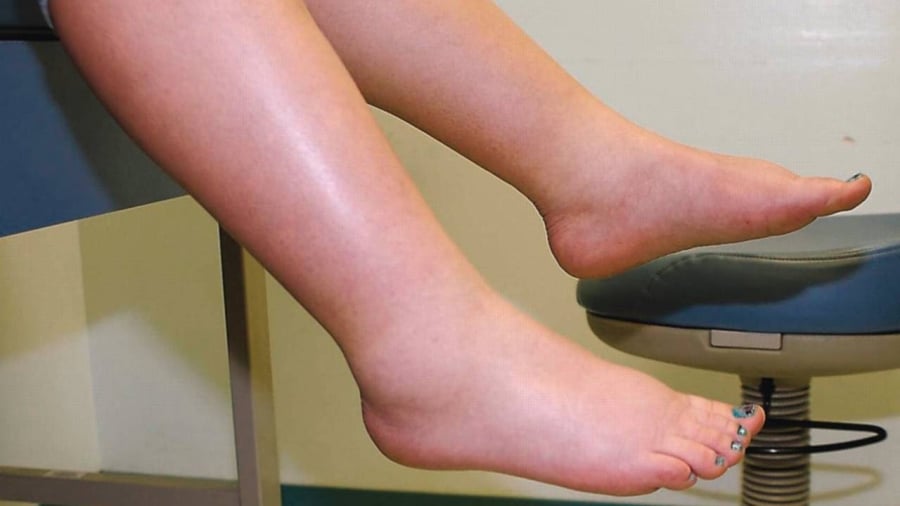According to Express, cardiovascular health is a major issue in the UK – it is the cause of about a quarter of all deaths each year. Cardiovascular diseases include conditions such as coronary heart disease, heart failure, and stroke…
According to the British Heart Foundation, about 7.6 million people in the UK are currently living with cardiovascular disease, and this number is expected to rise.
According to the World Health Organization (WHO), in Vietnam, cardiovascular disease accounted for 31% of total deaths in 2016. The prevalence of hypertension in adults aged 18-69 is 18.9%, according to the 2015 STEPS non-communicable disease risk factors survey, but only 13.6% of hypertensive patients were reported to be managed at a health facility.
If not detected and treated early, cardiovascular disease can be fatal. Therefore, it is crucial to recognize any warning signs.

3 skin indicators that may warn of heart disease
While chest pain is a well-known symptom of heart disease, there are lesser-known signs. According to an expert, there are surprising skin indicators that may warn of heart disease.
Dr. Dustin Portela, a dermatologist, recently took to TikTok to raise awareness about these signs.
“Did you know that dermatologists are trained to look for clues to heart disease on the skin?” Dr. Portela said.
“Dermatologists are trained to look for signs of internal disease that appear on the skin. These are some signs that could indicate a risk or heart disease.”
According to Dr. Portela, these three signs are:
– Swollen feet
– Clubbed fingers
– Frank’s sign (a diagonal crease in the earlobe).
Explaining further, the expert said: “First is swelling of the feet, particularly pitting edema in both feet.”
Pitting edema in both feet means swelling that affects both legs, such as both feet instead of just one.
“When you have swollen feet, it can be a sign of heart failure,” Dr. Portela said.
According to the Mayo Clinic’s website, bilateral pitting edema occurs when the lower chambers of the heart stop pumping blood effectively. Blood can “pool” in the feet, ankles, and legs, leading to edema.
Dr. Portela continued: “Next is clubbed fingers, in which the nail curves downward while the fingertip swells. This can be a sign of heart disease, heart infection, or lung disease.”
If you have clubbed fingers, your nails may become soft and look like a round ball, warm to the touch.
Cleveland Clinic describes this phenomenon as causing nails to have a “rounded, bulbous appearance, resembling an upside-down spoon.” The nails may also have a reddish color.
Dr. Portela added: “And finally, there’s Frank’s sign, a diagonal crease in the earlobe, which could be a sign of heart disease.”
A study published in the BMJ journal found a “significant association” between Frank’s sign and an increased risk of ischemic heart disease and angina.
10 heart-healthy foods
1. Salmon
Salmon and other fatty fish like tuna and mackerel are considered to be heart-healthy foods. This is because they contain a large amount of omega-3 fatty acids. Omega-3 fatty acids are believed to reduce the risk of arrhythmias. The American Heart Association recommends eating fatty fish twice a week.
2. Oatmeal
Oatmeal is rich in soluble fiber, which can help lower cholesterol and stabilize blood sugar levels. It is best to avoid instant oatmeal as they contain added sugars, instead, make your own oatmeal at home.
3. Blueberries
Blueberries, strawberries, and other berries can reduce the risk of heart disease. A study found that women who ate three servings of blueberries and strawberries per week reduced their risk of heart attack by 32% compared to those who ate less. This is due to components such as anthocyanins and flavonoids in blueberries that lower blood pressure and thus dilate blood vessels.
4. Dark chocolate
Several studies have shown that dark chocolate is good for your heart. Consuming dark chocolate daily can reduce heart attacks and strokes. Dark chocolate should contain at least 60-70% cocoa, thus preventing cardiovascular disease. They contain flavonoids called polyphenols, which can be beneficial for blood pressure, blood clotting, and inflammation. However, milk chocolate does not contain as much of these components.
5. Citrus fruits
A large amount of flavonoids in oranges and grapefruits helps prevent cardiovascular disease. People who eat a lot of citrus fruits, especially women, reduce their risk of stroke due to local ischemia, caused by blood clots. Citrus fruits are also rich in vitamin C, which is related to a reduced risk of heart disease.
6. Potatoes
Potatoes are high in potassium, which helps reduce blood pressure. They also contain a lot of fiber which helps reduce the risk of heart disease.
7. Tomatoes
Tomatoes are rich in heart-healthy potassium and contain antioxidants called lycopene. Lycopene is a carotenoid that can help remove bad cholesterol, dilate blood vessels, and reduce the risk of heart attack. Tomatoes are low in calories and sugar.
8. Nuts
Nuts such as almonds, walnuts, pistachios, and peanuts are all rich in beneficial fiber for cardiovascular health. Nuts also contain vitamin E and omega-3 fatty acids that reduce bad cholesterol. Studies have shown that people who eat nuts daily are leaner than those who don’t.
9. Leafy greens
Leafy greens like kale, spinach, and broccoli boost heart health. These greens are rich in carotenoids, act as antioxidants, and are devoid of harmful components. They also contain plenty of fiber and a variety of minerals, vitamins, and that’s why they are good for health.
10. Pomegranate
Pomegranates contain antioxidants including polyphenols and anthocyanins that enhance heart health, reduce arterial stiffness. A study found that drinking pomegranate juice daily for 3 months can improve blood flow to the heart.
Unlock 8 Benefits with a Daily 5-Minute Jog
Living a hectic lifestyle can make fitting in time to exercise difficult. However, studies have revealed that even just 5 minutes of jogging a day can lead to positive outcomes for your health, including a decrease in the risk of developing cardiovascular disease, extending your life span by up to 3 years, or even reducing the susceptibility to heart disease.




































